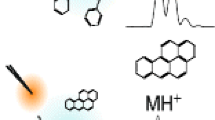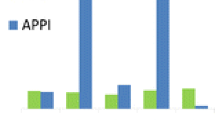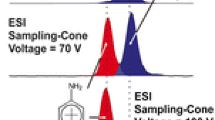Abstract
We provide experimental and theoretical evidence that the primary ionization process in the dopant-assisted varieties of the atmospheric pressure ionization methods atmospheric pressure photoionization and atmospheric pressure laser ionization in typical liquid chromatography–mass spectrometry settings is—as suggested in the literature—dopant radical cation formation. However, instead of direct dopant radical cation–analyte interaction—the broadly accepted subsequent step in the reaction cascade leading to protonated analyte molecules—rapid thermal equilibration with ion source background water or liquid chromatography solvents through dopant ion–molecule cluster formation occurs. Fast intracluster chemistry then leads to almost instantaneous proton-bound water/solvent cluster generation. These clusters interact either directly with analytes by ligand switching or association reactions, respectively, or further downstream in the intermediate-pressure regions in the ion transfer stages of the mass spectrometer via electrical-field-driven collisional decomposition reactions finally leading to the predominantly observed bare protonated analyte molecules [M + H]+.











Similar content being viewed by others
Notes
Purcell et al. [1] dissolved bitumen samples in perdeuterated toluene and subjected the mixture directly to high-resolution APPI Fourier transform ion cyclotron resonance analysis. Deuterated toluene donated a deuteron to only 10–15 % of the even-electron ions formed from pyridinic nitrogen model compounds.
E r = E/N, where E is the electrical field strength (V/cm) and N is molecular number density (molecule per cubic centimeter), resulting in the unit volt square centimeter per molecule. More conveniently, 1 Td (townsend) = 10-17 V cm2/molecule.
There is also a very good and comprehensive tutorial on buffer gas cooling of ion beams by Moore [20]. There one actually learns why ground loops in combination with high-voltage surges may result in a good number of bottles of beer being wasted.
References
Purcell JM, Hendrickson CL, Rodgers RP, Marshalla AG (2007) Atmospheric pressure photoionization proton transfer for complex organic mixtures investigated by Fourier transform ion cyclotron resonance mass spectrometry. J Am Soc Mass Spectrom 18:1682–1689
Kebarle P, Searles SK, Zolla A, Scarborough J, Arshadi M (1967) The solvation of the hydrogen ion by water molecules in the gas phase. Heats and entropies of solvation of individual reactions: H+(H2O)n-1 + H2O →H+(H2O)n. J Am Chem Soc 89(23):6393–6399
Kebarle P, Haynes RN, Collins JG (1967) Competitive solvation of the hydrogen ion by water and methanol molecules studied in the gas phase. J Am Chem Soc 89(23):5753–5757
Good A, Durden DA, Kebarle P (1979) Ion-molecule reactions in pure nitrogen and nitrogen containing traces of water at total pressures 0.5-4 torr. Kinetics of clustering reactions forming H+(H2O)n. J Chem Phys 52(1):212–221
Bohme DK, Mackay GI, Tanner SD (1978) An experimental study of the gas-phase kinetics of reactions with hydrated H3O+ ions (n = 1-3) at 298 K. J Am Chem Soc 101(14):3724–3730
Lau YK, Ikuta S, Kebarle P (1982) Thermodynamics and kinetics of the gas-phase reactions: H3O+(H2O)n-1 + H2O = H3O+(H2O)n. J Am Chem Soc 104:1462–1469
Zook DR, Grimsrud EP (1988) Measurement of ion clustering equilibria of proton hydrates by atmospheric pressure ionization mass spectrometry. J Phys Chem 92:6374–6379
Sunner J, Nicol G, Kebarle P (1988) Factors determining relative sensitivity of analytes in positive mode atmospheric pressure ionization mass spectrometry. Anal Chem 60:1300–1307
Kambara H, Kanomata I (1976) Collisional dissociation in atmospheric pressure ionization mass spectrometry. Mass Spectrosc (Japan) 24(4):271–282
Kambara H, Kanomata I (1977) Collision-induced dissociation of water cluster ions at high pressure. Int J Mass Spectrom Ion Phys 25:129–136
Albrecht S, Klopotowski S, Derpmann V, Klee S, Brockmann K J, Stroh F, Benter T (2013) Studies of the mechanics of the cluster formation in a thermally sampling API MS. Submitted to Rev Sci Instrum
Barnes I, Kersten H, Wissdorf W, Pöhler T, Hönen H, Klee S, Brockmann KJ, Benter T (2010) Novel laminar flow ion sources for LC- and GC-API MS. In: Proceedings of the 58th ASMS conference on mass spectrometry and allied topics, Salt Lake City, Utah, USA
Klopotowski S, Brachthäuser Y, Müller D, Kersten H, Wissdorf W, Brockmann KJ, Benther T (2012) Characterization of API-MS inlet capillary flow: examination of transfer times and choked flow conditions. In: Proceedings of 60th ASMS conference on mass spectrometry and allied topics, Vancouver, British Colombia, Canada
Klopotowski S, Brachthäuser Y, Müller D, Kersten H, Wissdorf W, Derpmann V, Klee S, Brockmann KJ, Janoske U, Gregor H, Benter T (2011) API-MS transfer capillary flow: examination of the downstream gas expansion. In: Proceedings of the 59th ASMS conference on mass spectrometry and allied topics, Denver, Colorado, USA
Jelezniak M, Jelezniak I (2009) CHEMKED 3.3. http://www.chemked.com. Accessed 23 Feb 2013
Wissdorf W, Seifert L, Derpmann V, Klee S, Vautz W, Benter T (2013) Monte Carlo simulation of ion trajectories of reacting chemical systems: mobility of small water clusters in ion mobility spectrometry. J Am Soc Mass Spectrom. doi:10.1007/s13361-012-0553-1
Wissdorf W, Pohler L, Klee S, Müller D, Benter T (2012) Simulation of ion motion at atmospheric pressure: particle tracing versus electrokinetic flow. J Am Soc Mass Spectrom 23:397–406
Wissdorf W, Lorenz M, Pöhler T, Höhnen H, Benter T (2013) Atmospheric pressure ion source development: experimental validation of simulated ion trajectories within complex flow and electrical fields. J Am Soc Mass Spectrom
Lorenz M, Klee S, Mönnikes R, Mangas Suárez AL, Brockmann, KJ, Schmitz OJ, Gäb S, Benter T (2008) Atmospheric pressure laser ionization (APLI): investigations on ion transport in atmospheric pressure ion sources. In: Proceedings of 56th ASMS conference on mass spectrometry and allied topics, Denver, Colorado, USA
Moore RB (2002) Buffer gas cooling of ion beams. http://www.physics.mcgill.ca/~moore/Notes/BeamCooling.pdf. Accessed Dec 2012
Douglas DJ, French JB (1992) Collisional focusing effects in radio frequency quadrupoles. J Am Soc Mass Spectrom 3:398
Searcy JQ, Fenn JB (1974) Clustering of water on hydrated protons in a supersonic free jet expansion. J Chem Phys 61(12):5282–5288
Imasaka T, Moore DS, Vo-Dinh T (2003) Critical assessment: use of supersonic jet spectrometry for complex mixture analysis. Pure Appl Chem 75(7):975–998
Searcy JQ (1975) A kinetic model for clustering of water on hydrated protons on a supersonic free jet expansion. J Chem Phys 63(10):4114–4119
Yang X, Castleman AW Jr (1989) Large protonated water clusters H+(H2O)n (1 ≤ n > 60): the production and reactivity of clathrate-like structures under thermal conditions. J Am Chem Soc 111:6845–6846
Kauppila TJ, Kostiainen R, Bruins AP (2004) Anisole, a new dopant for atmospheric pressure photoionization mass spectrometry of low proton affinity, low ionization energy compounds. Rapid Commun Mass Spectrom 18:808–815
Syage JA (2004) Mechanism of [M + H]+ formation in photoionization mass spectrometry. J Am Soc Mass Spectrom 15:1521–1533
Kappila T, Kostiainen R, Bruins AP (2005) Effect of the solvent flow rate on the ionization efficiency in atmospheric pressure photoionization-mass spectrometry. J Am Soc Mass Spectrom 16:1399–1407
Rob DB, Blades MW (2005) Effects of solvent flow, dopant flow, and lamp current on dopant-assisted atmospheric pressure photoionization (DA-APPI) for LC-MS. Ionization via proton transfer. J Am Soc Mass Spectrom 16:1275–1290
Bernstein ER, Li S (1992) Toluene-water clusters: ion fragmentation and chemistry. J Chem Phys 97:2–15
Miyazaki M, Fujii A, Abata T, Mikami N (2003) Infrared spectroscopy of hydrated benzene cluster cations, [C6H6-(H2O)n]+ (n = 1–6): structural changes upon photoionization and proton transfer reactions. Phys Chem Chem Phys 5:1137–1148
Kleinermanns K, Janzen C, Spangenberg D, Gerhards M (1999) Infrared spectroscopy of resonantly ionized (Phenol)(H2O)n +. J Phys Chem A 103:5232–5239
Cunningham AJ, Payzant JD, Kebarle P (1972) A kinetic study of the proton hydrate H+(H2O)n equilibria in the gas phase. J Am Chem Soc 94(22):7627–7632
Viggiano AA, Dale F, Paulson JF (1987) Proton transfer reactions of H+(H2O)n = 2-11 with methanol, ammonia, pyridine, acetonitrile, and acetone. J Chem Phys 88(4):2469–2477
Midey AJ, Williams S, Arnold ST, Viggiano AA (2002) Reactions of H3O+(H2O)0,1 with alkylbenzenes from 298 to 1200 K. J Phys Chem A 106:11726–11738
Adams NG, Bohme DK, Dunkin DB, Fehsenfeld FC, Ferguson EE (1970) Flowing afterglow studies of formation and reactions of cluster ions of O2 +, O2 −, and O−. J Chem Phys 52:3133–3140
Liang CW, Leea YT, Chena CH, Wang YS (2009) Ionizing nonvolatile samples using laser desorption–proton-transfer reaction with cluster reagent ions. Int J Mass Spectrom 291:61–66
Blake RS, Monks PS, Ellis AM (2009) Proton-transfer reaction mass spectrometry. Chem Rev 109:861–896
Shahin MM (1965) Mass spectrometric studies of corona discharges in air at atmospheric pressures. J Chem Phys 45:2600–2605
Acknowledgments
The instrument briefly described in this work was partly developed at the University of Wuppertal, Germany, to be finally installed at IEK-7 of Research Center Jülich, Germany. S.K., V.D., H.K., and T.B. are indebted to the director of the IEK-7, Martin Riese, and to Fred Stroh of IEK-7 for strongly supporting this work by a 1-year loan of the instrument to the University of Wuppertal. S.K. acknowledges a graduate student research fellowship from Bruker Daltonics, Bremen, Germany. S.A. acknowledges a graduate student research fellowship from Research Center Jülich. Part of this work was funded through grant Be 2124/6-1 of the German Research Foundation.
Author information
Authors and Affiliations
Corresponding author
Additional information
Published in the topical collection Photo Ionisation in Mass Spectrometry with guest editor Ralf Zimmermann.
Rights and permissions
About this article
Cite this article
Klee, S., Albrecht, S., Derpmann, V. et al. Generation of ion-bound solvent clusters as reactant ions in dopant-assisted APPI and APLI. Anal Bioanal Chem 405, 6933–6951 (2013). https://doi.org/10.1007/s00216-013-7114-8
Received:
Revised:
Accepted:
Published:
Issue Date:
DOI: https://doi.org/10.1007/s00216-013-7114-8




